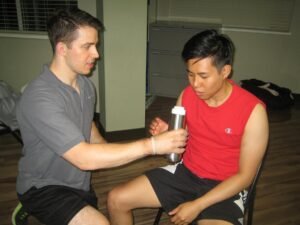Heat cramps are considered as severe muscle spasms due to a combination of prolonged exercise or activity, substantial sweating and excessive water loss during extreme heat.
When one sweats, the salts or electrolytes and fluids are lost, but drinking adequate amounts of water will lead to the dilution of the salts, resulting to heat cramps. Heavy sweating can likely occur during the summer season especially when engaged in any strenuous exercise or activity.

Always remember that excessive sweating due to extreme heat will lead to the depletion of the salts and fluids in the body. This will result to a low blood pressure and painful muscle contractions. With this condition, the fluid and salt loss ranges from mild to moderate. In severe cases, the fluid and salt loss are severely depleted which results to a heatstroke.
Who are at risk for heat cramps?
There are certain individuals who are prone to develop heat cramps. It includes manual laborers, mountain climbers and skiers. Cramps can also occur among athletes such as those playing tennis and runners who do not have enough time to replace the salts that are lost through sweating.
Symptoms of heat cramps
Heat cramps are best described as the rhythmic contractions in the muscles of the calves, hands, thighs, feet and the arms. In most cases, these contractions can cause the muscles to become tense, hard and painful.
Treatment for heat cramps
The first aid treatment for heat cramps can be provided before seeking medical care.
- Instruct the individual to stop the activity
- Transfer to a cooler place
- Provide a lot of fluids
- Gently stretch the cramping muscles
Painful muscles can be treated by providing over-the-counter anti-inflammatory medications such as naproxen or ibuprofen.
When to seek medical care?
Always bear in mind that heat cramps are treated right away. On the other hand, if it cannot be controlled, it is best to seek medical care. It is best to seek medical care if the following are observed:
- Individual has nausea or vomiting
- Fatigue and weakness
- Excessive sweating that does not stop even if transferred to a cooler place
How to prevent heat cramps
It is always best to prevent this condition from occurring and it is possible by simply using your common sense. As much as possible, avoid performing strenuous exercises or activities in a very hot environment, especially during the summer season.
During the summer season, you have to wear light, loose-fitting clothes that are made out of breathable cloth such as cotton. If you sweat a lot, you can replace the fluids and salts lost by drinking beverages or foods that contain salt. You should also drink adequate amount of fluids even after your thirst is quenched. In case you have to engage in a rigorous activity in a hot environment, you have to drink a lot of water and regularly cool the skin by wetting or misting it with cool water in order to keep the body temperature at a normal range.
During the summer season, it is important to avoid any strenuous activity if possible. If heat cramps are left untreated, the fluid and salt loss will worsen, resulting to severe cases such as heat exhaustion or even a heatstroke.
